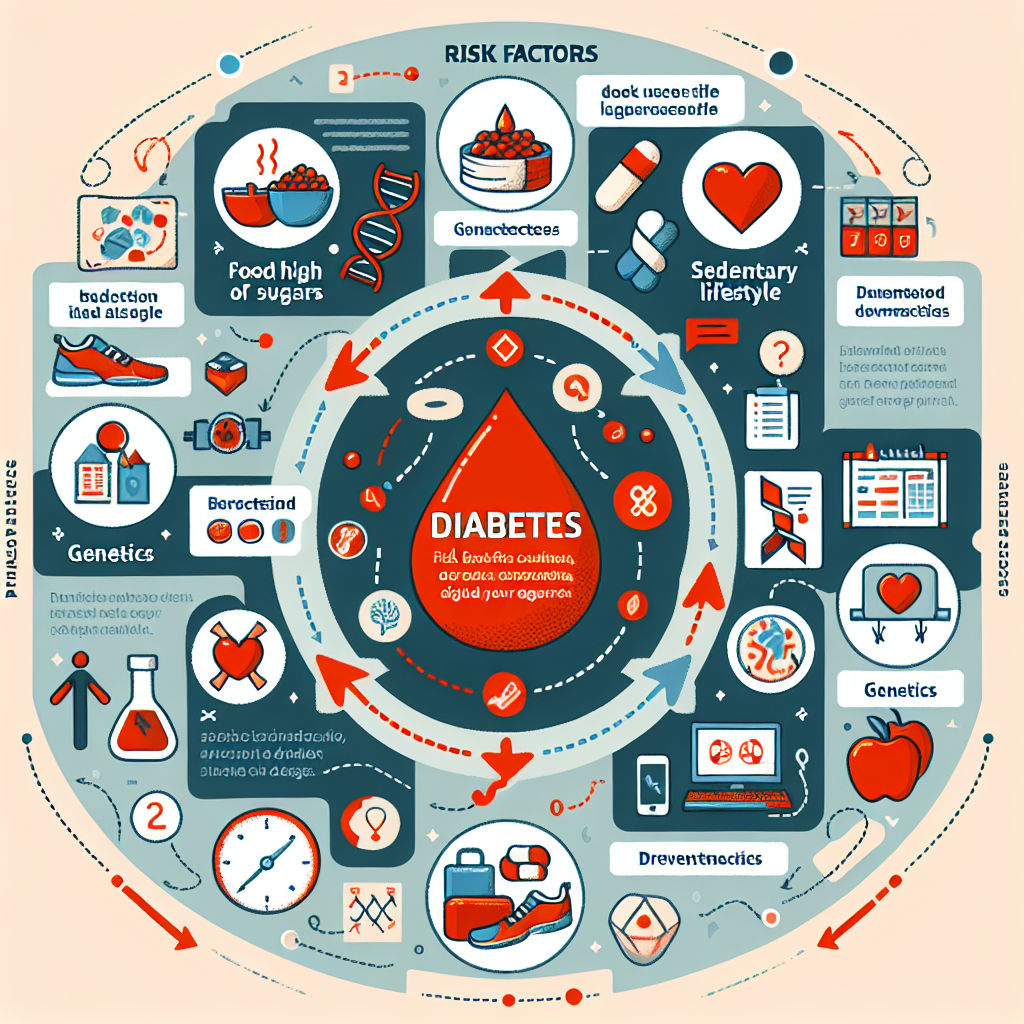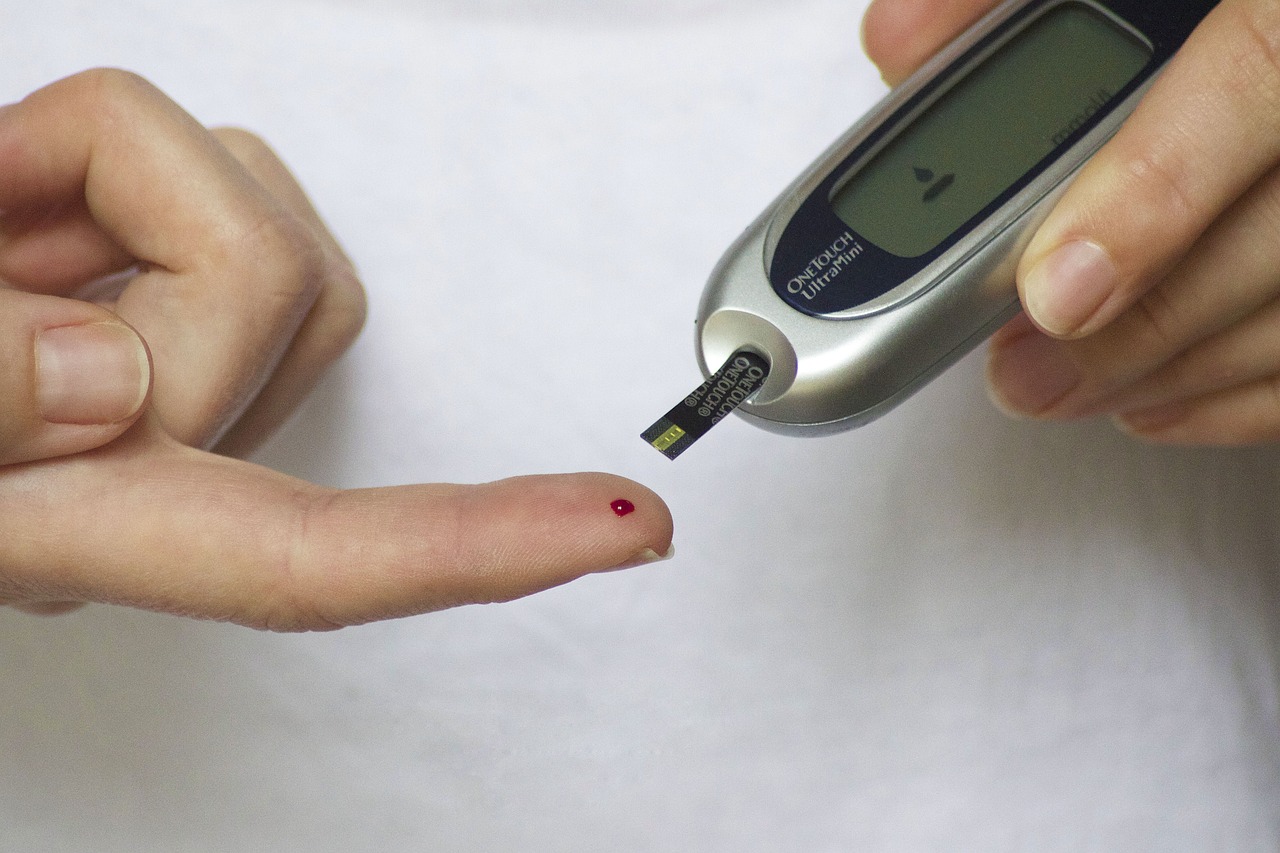In this article, you will explore the various risk factors associated with the development of diabetes. Understanding these factors can help you assess your own risk and take proactive steps towards prevention and management.
From genetic predispositions to lifestyle choices, we will shed light on the factors that contribute to this prevalent chronic condition. So, let’s delve into the world of diabetes risk factors and empower ourselves with knowledge for a healthier future.
Age
Older age
As you get older, your risk of developing diabetes increases. This is because as you age, your body becomes less efficient at producing and using insulin, the hormone responsible for regulating blood sugar. According to the American Diabetes Association, the risk of developing type 2 diabetes doubles every five years after the age of 45.
This is partly due to lifestyle factors, such as weight gain and decreased physical activity, that tend to occur as people age. However, type 1 diabetes can also develop at any age, including in older adults.
Prediabetes in children
Traditionally, diabetes has been seen as a disease that primarily affects older adults. However, there has been a concerning rise in the number of children and adolescents being diagnosed with prediabetes, a condition in which blood sugar levels are higher than normal but not yet in the diabetes range.
The Centers for Disease Control and Prevention estimates that around 84 million adults and children in the United States have prediabetes, with about ⅓ of them being children. Prediabetes in children can progress to type 2 diabetes if left untreated, making early detection and intervention crucial.
Gestational diabetes
Gestational diabetes occurs during pregnancy and affects approximately 2-10% of pregnant women. While the exact cause is unknown, hormonal changes during pregnancy can make it more difficult for the body to use insulin effectively.
This type of diabetes usually resolves after giving birth, but women who have had gestational diabetes have an increased risk of developing type 2 diabetes later in life. Additionally, babies born to mothers with gestational diabetes are at a higher risk of developing obesity and type 2 diabetes themselves.
Weight and Obesity
Overweight and obesity
Being overweight or obese is a significant risk factor for developing type 2 diabetes. When you carry excess weight, especially in your abdomen, it can lead to insulin resistance, where your body’s cells become less responsive to insulin.
This resistance prevents glucose from entering cells efficiently, resulting in elevated blood sugar levels. Losing weight, even a modest amount, can greatly reduce your risk of developing diabetes or help manage the condition if you have already been diagnosed.
Excess abdominal fat
The location of your fat storage can also impact your diabetes risk. Excess abdominal fat, often referred to as visceral fat, is particularly problematic as it is closely linked to insulin resistance and other metabolic disorders. This type of fat surrounds vital organs like the liver, pancreas, and intestines, releasing hormones and substances that can disrupt normal insulin function.
To assess whether you have excess abdominal fat, measure your waist circumference. For men, a waist circumference of 40 inches (102 cm) or more, and for women, 35 inches (88 cm) or more, indicates an increased risk of developing diabetes.
Body composition (muscle and fat ratio)
The ratio of muscle to fat in your body composition also plays a role in determining your diabetes risk. Having more muscle mass generally increases insulin sensitivity, enabling your body to use insulin more efficiently. On the other hand, a higher percentage of body fat, especially when accompanied by low muscle mass, can lead to insulin resistance.
Regular strength-training exercises can help increase muscle mass and improve insulin sensitivity, reducing your risk of developing diabetes.

Family History and Genetics
Family history of diabetes
Having a family history of diabetes can increase your risk of developing the disease. If one or both of your parents have diabetes, you are more likely to develop it yourself. This increased risk may be due to shared genetic factors or shared lifestyle habits within the family.
However, it’s essential to remember that having a family history of diabetes does not mean you will definitively develop the disease. It simply means you may be more susceptible and should be more vigilant about managing your risk factors.
Genetic factors
In addition to family history, specific genetic factors can also contribute to an increased risk of diabetes. Scientists have identified several genes that play a role in the development of both type 1 and type 2 diabetes. However, genetics alone are not the sole determinant of whether you will develop diabetes.
Lifestyle factors, such as diet and physical activity, also play a significant role. Understanding your genetic risk factors can help you make informed decisions about your lifestyle and healthcare.
Ethnicity
Certain ethnic groups have a higher prevalence of diabetes compared to others. For example, African Americans, Hispanic/Latino Americans, American Indians, Asian Americans, and Pacific Islanders are at a higher risk for developing diabetes compared to non-Hispanic white individuals.
These disparities may be influenced by a combination of genetic factors, cultural practices, and socioeconomic factors. However, it’s important to note that anyone, regardless of their ethnicity, can develop diabetes, and lifestyle choices remain crucial in reducing risk.
Physical Inactivity
Lack of regular exercise
Engaging in regular physical activity is essential for maintaining overall health and reducing the risk of developing diabetes. When you are physically active, it helps your body use insulin more effectively and improves insulin sensitivity.
On the other hand, a sedentary lifestyle, characterized by prolonged periods of sitting or inactivity, can lead to weight gain, insulin resistance, and an increased risk of diabetes. Aim for at least 150 minutes of moderate-intensity aerobic activity, such as brisk walking or cycling, every week to lower your risk.
Sedentary lifestyle
A sedentary lifestyle, which involves minimal physical activity and prolonged sitting or lying down, is a significant risk factor for diabetes. Even if you meet the recommended exercise guidelines, sitting for extended periods without breaks can still increase your risk.
Studies have shown that individuals who spend more than seven hours a day seated have a higher likelihood of developing diabetes. To reduce your risk, try incorporating regular movement breaks throughout the day, such as standing up and stretching every hour.

Ethnicity
Certain ethnic groups
Certain ethnic groups have a higher risk of developing diabetes compared to others. These include African Americans, Hispanic/Latino Americans, American Indians, Asian Americans, and Pacific Islanders. The reasons behind these disparities are multifactorial and can include genetic predispositions, cultural factors, and socioeconomic challenges.
For example, African Americans and Hispanic/Latino Americans are more likely to experience higher rates of obesity and have lower access to healthcare and diabetes management resources. It’s crucial for individuals from these ethnic groups to prioritize early detection and proactive management of diabetes risk factors.
Higher risk for certain populations
Within ethnic groups, specific populations may face an even higher risk of developing diabetes. For example, Mexican Americans and Puerto Ricans have higher rates of diabetes compared to other Hispanic/Latino subgroups.
Similarly, South Asians, such as individuals from India, Bangladesh, Pakistan, and Sri Lanka, are at an increased risk of developing diabetes compared to other Asian populations. These heightened risks may be attributed to a combination of genetic factors, cultural practices, and lifestyle habits unique to these populations.
High Blood Pressure
Hypertension (high blood pressure)
High blood pressure, or hypertension, is a significant risk factor for diabetes. The relationship between the two conditions is complex, with each contributing to the worsening of the other. Having high blood pressure can damage blood vessels, including those responsible for delivering oxygen and nutrients to the pancreas, impairing its ability to produce insulin.
Conversely, diabetes can lead to insulin resistance, promoting the development of high blood pressure. Managing blood pressure is crucial for reducing the risk of diabetes and other cardiovascular complications.
Prehypertension
Prehypertension, a condition characterized by blood pressure levels higher than normal but not yet in the hypertension range, also increases the risk of developing diabetes. Research has shown that individuals with prehypertension have a significantly higher likelihood of developing type 2 diabetes compared to those with normal blood pressure.
Lifestyle modifications, such as adopting a healthy diet, engaging in regular physical activity, and managing stress, can help prevent prehypertension from progressing to hypertension and subsequently reduce the risk of diabetes.

Unhealthy Diet
Poor nutrition
A diet high in unhealthy foods and low in essential nutrients is a significant risk factor for developing diabetes. Consuming excessive amounts of processed foods, fast food, sugary snacks, and beverages contributes to weight gain, insulin resistance, and elevated blood sugar levels.
It’s important to prioritize a balanced and nutritious diet that includes a variety of whole foods, such as fruits, vegetables, lean proteins, and whole grains. Limiting your intake of added sugars, saturated and trans fats, and sodium can also help reduce your diabetes risk.
High intake of sugar and processed foods
High sugar and processed food consumption are strongly associated with an increased risk of diabetes. Sugary beverages, such as sodas and fruit juices, are particularly problematic as they have a high glycemic load, rapidly increasing blood sugar levels.
Processed foods, which often contain added sugars, unhealthy fats, and high levels of sodium, can contribute to weight gain, inflammation, and insulin resistance. Opting for whole, unprocessed foods whenever possible and being mindful of hidden sugars in packaged products can help lower your risk.
Low intake of fruits, vegetables, and whole grains
On the flip side, low intake of fruits, vegetables, and whole grains is also linked to a higher risk of developing diabetes. These foods are rich in dietary fiber, vitamins, minerals, and antioxidants, all of which play a crucial role in maintaining blood sugar control and overall health. Including a variety of colorful fruits and vegetables and choosing whole grain options, such as whole wheat bread and brown rice, can provide essential nutrients and promote a healthier diet.
Smoking
Active smoking
Smoking is a well-established risk factor for numerous health conditions, including diabetes. Smokers have a significantly higher risk of developing type 2 diabetes compared to nonsmokers. The chemicals in tobacco smoke can disrupt insulin production and release, leading to insulin resistance.
Smoking also increases inflammation and oxidative stress in the body, further contributing to the development of diabetes and other chronic diseases. Quitting smoking is one of the most impactful steps you can take to improve your overall health and lower your diabetes risk.
Passive smoking
Even if you are not a smoker yourself, exposure to secondhand smoke can still increase your risk of developing diabetes. Breathing in the smoke from someone else’s cigarette can have detrimental effects on your health, including impairing insulin sensitivity and worsening metabolic function. If you live or work with smokers or frequently find yourself in environments where smoking is allowed, take steps to minimize your exposure to secondhand smoke to protect your health.

Gestational Factors
Gestational diabetes
Gestational diabetes occurs during pregnancy and affects about 2-10% of pregnant women. It is characterized by high blood sugar levels that can pose risks to both the mother and the baby. Gestational diabetes typically resolves after childbirth, but women who have had it are at an increased risk of developing type 2 diabetes later in life.
Additionally, babies born to mothers with gestational diabetes have a higher risk of developing obesity and type 2 diabetes themselves. Regular prenatal care that includes glucose screening and appropriate management is important in reducing the impact of gestational diabetes.
Giving birth to a baby weighing over 9 pounds
If you have given birth to a baby weighing over 9 pounds, also known as macrosomia, it can increase your risk of developing diabetes. This is because delivering a large baby is often associated with gestational diabetes or poorly controlled blood sugar levels during pregnancy.
The strain on the pancreas to produce more insulin can lead to long-term insulin resistance and an increased risk of type 2 diabetes for the mother. Close monitoring of blood sugar levels during pregnancy and effective management of gestational diabetes can help minimize the risk of delivering a large baby and subsequent diabetes development.
Medical Conditions
Polycystic ovary syndrome (PCOS)
Polycystic ovary syndrome (PCOS) is a hormonal disorder that affects many women of reproductive age. Women with PCOS often have elevated levels of insulin, higher than normal androgens (male hormones), and irregular or absent menstrual cycles.
The combination of these factors increases the risk of developing insulin resistance and diabetes. Managing PCOS through lifestyle modifications, such as weight loss and a healthy diet, can help improve insulin sensitivity and reduce the likelihood of developing diabetes.
High cholesterol levels
Having high cholesterol levels, particularly elevated levels of low-density lipoprotein (LDL) cholesterol, can increase your risk of developing diabetes. High cholesterol levels are often associated with other metabolic disorders, such as obesity and insulin resistance.
Over time, these factors can contribute to the development of type 2 diabetes. Regular cholesterol screenings and appropriate management of cholesterol levels through diet, exercise, and medication, if necessary, are important for reducing diabetes risk.
Sleep disorders (e.g., sleep apnea)
Sleep disorders, such as sleep apnea, have been linked to an increased risk of developing diabetes. Sleep apnea is a condition characterized by pauses in breathing or shallow breaths during sleep, leading to poor-quality sleep and insufficient oxygen supply to the body.
The chronic sleep deprivation and oxygen deficiency associated with sleep apnea can trigger metabolic disturbances, such as insulin resistance, glucose intolerance, and weight gain, increasing the risk of diabetes. Seeking diagnosis and treatment for sleep disorders is crucial for maintaining overall health and reducing diabetes risk.
History of cardiovascular disease
A history of cardiovascular disease, including conditions such as heart attack, stroke, or peripheral artery disease, can also increase your risk of developing diabetes. There is a significant overlap between cardiovascular disease and diabetes, with shared risk factors, such as high blood pressure, high cholesterol levels, and obesity.
Insulin resistance and chronic inflammation, common in both conditions, further contribute to the increased risk. Managing cardiovascular risk factors through lifestyle modifications and appropriate medical treatments can help reduce the likelihood of developing diabetes.
Certain medications
Certain medications, such as glucocorticoids (commonly prescribed for conditions like asthma and autoimmune disorders), statins (used to lower cholesterol levels), and some antipsychotic medications, have been associated with an increased risk of diabetes.
These drugs can impair insulin secretion or promote insulin resistance, leading to elevated blood sugar levels and the development of diabetes. If you are taking any medications long-term, it’s important to discuss potential risks and side effects with your healthcare provider and monitor your blood sugar levels regularly.
In conclusion, while the development of diabetes can be influenced by various factors, understanding and managing these risk factors can significantly reduce your chances of developing the disease.
Age, weight and obesity, family history and genetics, physical inactivity, ethnicity, high blood pressure, an unhealthy diet, smoking, gestational factors, medical conditions, and certain medications all play a role in determining your risk. By adopting a healthy lifestyle, including regular exercise, a balanced diet, avoiding smoking, and managing chronic conditions, you can take proactive steps to protect yourself against diabetes and enjoy a healthier life. Remember, it’s never too late to make positive changes and prioritize your long-term health.

We have another great article that covers diabetes: What Are The Main Symptoms Of Diabetes?

